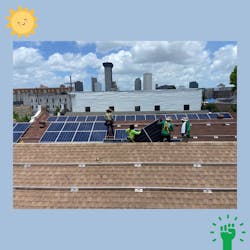When the provisions of the game-changing Inflation Reduction Act (IRA) were first released about a year ago, the focus was on microgrid and distributed energy resources (DER) developers’ ability to get Investment Tax Credits (ITC) and Production Tax Credits (PTC) as high as 70%.
That’s possible if they meet requirements that aim to ensure systems are built in the U.S., provide jobs for U.S. workers and benefit low-income communities – among other provisions.
The IRA, indeed, has driven investment in clean energy. The Solar Energy Industries Association said that as a result of the measure, U.S. solar and storage companies have announced more than $100 billion in new private sector investments.
But in their quest to realize expected benefits, many potential developers and owners of microgrid and DER projects may get hung up on the apprenticeship and prevailing wage requirements, said Jerome Garciano, a shareholder of Polsinelli law firm who specializes in clean energy.
Apprenticeship and wage provisions could be a headache
“These provisions will have the most widespread impact, and they will be the biggest headache and require the most paperwork,” Garciano said. Not only are the ITCs and PTCs affected but so are many lesser known tax credits also included in the IRA. They include a section – the Alternative Fuel Infrastructure Tax Credit for businesses (Section 30C) – that provides tax credits for electric vehicle infrastructure.
DER projects 1 MW and above are subject to the wage and apprenticeship requirements, while those with less than 1 MW are not required to follow them. For projects that are 1 MW and above, failure to follow the provisions of the IRA could lead to these projects getting only a 6% tax credit. In addition, project owners and developers may have to pay the Internal Revenue Service (IRS) high fines for failing to pay workers prevailing wages, which are basically union wages but workers don’t have to be union, said Garciano.
One of every four workers must be an apprentice
The IRA’s apprenticeship requirements call for one out of every four workers to be an apprentice, and each trade must follow the guidelines separately, he said. Developers cannot group the trades and then say that they have met the apprenticeship requirements.
Project investors seeking to buy tax credits will be looking to ensure that projects meet all the wage and apprenticeship requirements, Garciano added.
But hiring qualified apprentices – especially in fairly new industries – isn’t easy, said Garciano.
Apprentices must be trained under federally registered apprenticeship programs or state registered programs. California, for example, has its own program.
In some cases, no apprenticeship programs are available for people working in the clean energy industry, Garciano said.
“The industry has to get together to address these issues and try to figure out if there’s apprenticeship programs they want to start for some of these new occupations and trades and categorize them,” he said.
The good faith exception
If microgrid and DER developers and owners can’t find a qualifying apprenticeship program, they can apply for a good faith exception, which means they don’t have to meet the requirements. But they have to reapply every 120 days and demonstrate that no programs are available, Garciano said.
The prevailing wage requirements also call for microgrid and DER developers to pay prevailing wages for projects 1 MW and larger, and to document their payments. Different trades have different prevailing wages. The federal Department of Labor establishes the standards for each type of labor.
“Imagine all the record keeping: the name of every person, time in and out, payments. It’s
a pretty Herculean task,” said Garciano.
If developers and owners fail to pay prevailing wages, they must pay the IRS penalties.
“If you are a project owner and take the tax credits, the IRS will audit you, especially in the beginning. If you take the 30% credit and you don’t have the right paperwork, the IRS could take away the credit,” he said.
IRA tax credits can be as high as 70%
If developers follow all the wage and apprenticeship requirements and also create projects that ensure manufacturing takes place in the U.S. and serve disadvantaged communities, they can get tax credits as high as 70%.
For the ITC and PTC, projects get an additional 10% credit if the equipment is domestically produced. They gain additional credits if projects are located in certain energy communities, such as where coal plants have closed, or in metropolitan communities that are fossil-fuel based and have high unemployment, said Garciano. Projects on tribal lands are eligible for a 10% bonus, and community solar projects for low-income communities can be eligible for a 20% bonus.
Celebrating the IRA’s achievements
Because of the potential to obtain such high credits, many celebrated the Aug. 16 anniversary of the IRA. Rocky Mountain Institute (RMI), for example, said that the IRA’s effect — on industrial investment, new jobs and other economic activity — has already exceeded expectations. According to RMI, the IRA sparked $258 billion in new private clean energy investments, projects that created 170,000 new jobs and the availability of $70 billion in grants, rebates and other funding.
But along with the celebration comes a warning: Pay attention to the IRA’s prevailing wage and apprenticeship requirements.
“People are gearing up to invest in projects but don’t realize the amount of paperwork that will be needed,” said Garciano.
Track news about microgrids. Subscribe to the free Microgrid Knowledge Newsletter.








